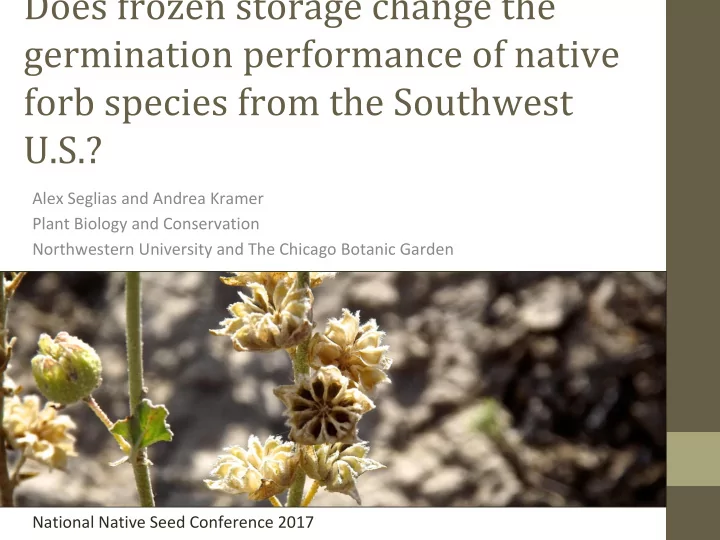

Alex Seglias and Andrea Kramer Plant Biology and Conservation Northwestern University and The Chicago Botanic Garden National Native Seed Conference 2017
Agriculture
Agriculture Conservation
Agriculture Conservation Restoration
National Center for Genetic Resources Preservation
• Southwest U.S. – Arizona, Colorado, New Mexico, Utah • Large-scale restorations • Limited availability of regional native plant material
• 7 common forb species* • Widespread throughout the Southwest • High priority species for use in large-scale restorations • Little information about dormancy and germination • Physiological and combinational dormancy • Orthodox *Selected from a list of species created by the Colorado Plateau Native Plant Program and collaborators
• Low moisture and temperature (-20°C or below) • Preservation of seeds for hundreds of years • Ex situ collections in case of extinction or population destruction
1. Southwestern native forb species will be amenable to seed banking conditions (i.e., drying and storing at sub-zero temperatures) 2. Germination response (proportion and rate) will not differ between non-frozen and frozen seeds 3. Seed bank storage effects will not differ within species
www.fs.fed.us www.fs.fed.u www.fs.fed.u s s Packera multilobata Dieteria canescens Heliomeris multiflora lobeleaf groundsel hoary tansyaster showy goldeneye www.fs.fed.us greatbasinnativeplants.co m Cleome serrulata Penstemon comarrhenus Plantago patagonica Sphaeralcea parvifolia Rocky Mountain beeplant dusty beardtongue woolly plantain small-leaf globemallow
Utah Colorado • Summer and fall 2015 • 9 populations • Seeds of Success protocols New Mexico Arizona UT CO AZ NM
1/2 Seed bank Clean seeds Collect seeds Seed dryer Plate seeds Stratification Incubation Score germination Cut tests
1/2 Seed bank Clean seeds Collect seeds Seed dryer Plate seeds Stratification Incubation Score germination Cut tests - - - - - - - - - - - - - - - - - - - - - - - - - - - - - - - - - - - - - - - - - - - - - - - - - - - - - - - - - - - - - - - - - - - - - - - - - - - No stratification 2 weeks 4 weeks 6 weeks 8 weeks 10 weeks (3°C) (3, 6, 9°C) (3, 6, 9°C) (3, 9°C) (3°C) - - - - - - - - - - - - - - - - - - - - - - - - - - - - - - - - - - - - - - - - - - - - - - - - - - - - - - - - - - - - - - - - - - - - - - - - - - - Incubation 20/10°C 25/15°C
All treatments shown Cox p-value = 0.001
All treatments shown Cox p-value = 0.18
Cox p-value = 0.05
All treatments shown Cox p-value = 0.58
All treatments shown Cox p-value = 0.03
All treatments shown Cox p-value = 0.49
All treatments shown Cox p-value = 0.03
Germination Percentage
1. Species are amenable 3. Effects do not differ 2. Germination does not to seed banking within species differ after freezing TRUE FOR MOST SPECIES DIETERIA CANESCENS SHOWS DIFFERENCE IN RATE
• All species have orthodox seeds and are amenable to seed banking • Dormancy and germination largely unchanged following seed bank storage • Effects were most pronounced during stratification for most species • Understanding early life stages is critical for restorations now and in the future
Andrea Kramer, Kay Havens, Evelyn Williams Kramer-Havens Lab Jessa Finch, Jacob Zeldin, Becky Barak, Olga K. Nora Talkington, Alicia Foxx, Lila Leatherman Rachel Hosna Patrick Alexander, Kathy See, Dustin Rooks Hau Truong and the Rio Mesa Center Funding: Northwestern Plant Biology and Conservation Robert D. Hevey and Constance M. Filling Native Plant Society of New Mexico BLM & Natural Areas Association
alexandraseglias2016@u.northwestern.edu
The preceding presentation was delivered at the 2017 National Native Seed Conference Washington, D.C. February 13-16, 2017 This and additional presentations available at http://nativeseed.info
Recommend
More recommend